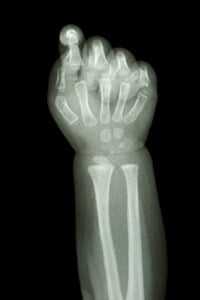Dangerous Birth Injuries
When complications occur during a child’s birth, serious birth injuries can cause your baby to suffer from debilitating conditions. In particular, a healthcare professional’s medical negligence can lead to a condition known as Erb’s Palsy. While the American Academy of Orthopaedic Surgeons (AAOS) indicates that only about “one or two of every 1,000 babies have this condition,” it is a severe injury that can prevent the maximum functioning of a child’s arm.
as Erb’s Palsy. While the American Academy of Orthopaedic Surgeons (AAOS) indicates that only about “one or two of every 1,000 babies have this condition,” it is a severe injury that can prevent the maximum functioning of a child’s arm.
What is Erb’s Palsy?
Erb’s palsy is a type of brachial plexus palsy. As such, it is a condition that results from an injury to a child’s brachial plexus at birth. According to the AAOS, the brachial plexus is a group of nerves close to the neck that control the nerves in the arm. Erb’s palsy typically involves injury to the upper nerves of the brachial plexus, and this is what distinguishes Erb’s palsy from other kinds of brachial plexus injuries, such as Klumpke palsy.
Causes of Erb’s Palsy
What causes a child to suffer from Erb’s palsy? Typically, the condition occurs from nerve injury during particularly delivery. Erb’s palsy is a “stretch injury” that results from the baby’s neck being stretched to pull out of the birth canal. In many cases of Erb’s palsy, a baby can move its fingers but cannot move its shoulder because of the injury. The severity of the injury can vary greatly, with some babies regaining movement in the shoulder and others suffering long-term disabilities.
Specifically, the following can occur during birth which can result in Erb’s palsy:
- Breech delivery, or feet-first, in which a healthcare professional applies pressure to a baby’s arms;
- Pulling of the baby’s head and neck to the side as the baby passes through the birth canal; and
- Pulling of the baby’s shoulders in a normal head-first delivery.
Signs and Symptoms of Erb’s Palsy
Depending on the specific injury, symptoms of Erb’s palsy can appear immediately or shortly after birth. However, the full extent of the injury may not be known immediately. Signs of Erb’s palsy often include the following:
- Not moving part of the arm or hand;
- Weakness or loss of feeling in the arm;
- Arm paralysis;
- Arm bent at elbow and held closely to the body;
- Inability or decreased ability to grip with one hand; or
- Little or no spontaneous movement of the arm or the hand.
After a child begins showing symptoms, a pediatrician typically will diagnose the condition. Depending on the severity of the condition, your child likely will require daily physical therapy in order to treat Erb’s palsy. When physical therapy fails to improve the condition, some doctors may recommend surgery to treat the nerve damage.
Some infants with Erb’s palsy will battle with this condition for the rest of their lives. Indeed, children with Erb’s palsy often have one arm that is shorter than the other due to nerve damage at birth. If your child sustained a serious birth injury like Erb’s palsy during delivery, it is important to speak to an experienced birth injury lawyer about your case.







